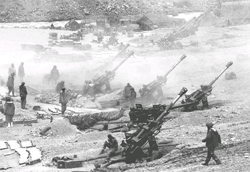When nature strikes
 did early spring in Kargil help the Pakistan-backed intruders occupy strategic heights on the Indian side of the Line of Control ( loc )? Some experts believe so. The first signs of Pakistani intrusion became known on May 14 at Kaksar. Lt Gen Satish Nambiar, director of the United Services Institution, India's oldest defence thinktank, says that the early arrival of spring in the Drass-Kargil area caused the snow to melt earlier than usual. This enabled the Border Roads Organisation ( bro ) to open the crucial Srinagar-Leh national highway almost three weeks ahead of schedule. If the weather pattern had been normal, the national highway would not have opened until June 1. The thaw facilitated the early opening of the Zojila Pass and a quick mobilisation of personnel and materials in the zone, says Nambiar.
did early spring in Kargil help the Pakistan-backed intruders occupy strategic heights on the Indian side of the Line of Control ( loc )? Some experts believe so. The first signs of Pakistani intrusion became known on May 14 at Kaksar. Lt Gen Satish Nambiar, director of the United Services Institution, India's oldest defence thinktank, says that the early arrival of spring in the Drass-Kargil area caused the snow to melt earlier than usual. This enabled the Border Roads Organisation ( bro ) to open the crucial Srinagar-Leh national highway almost three weeks ahead of schedule. If the weather pattern had been normal, the national highway would not have opened until June 1. The thaw facilitated the early opening of the Zojila Pass and a quick mobilisation of personnel and materials in the zone, says Nambiar.
Many experts quoted in newspaper reports feel that the Pakistani game plan was to assist the mercenaries in occupying the vacated portions of the Kargil-Drass region so they could become a constant source of harassment along the highway. The loc has barren mountains on either side that are not occupied by either India or Pakistan because of the sheer logistics involved, they say. It is virtually impossible to hold on to the area during the winter months, so the Indian Army doesn't even patrol these portions. Therefore, it came as a surprise to Army intelligence when the first patrols reported the presence of large groups of armed men along the heights.
"The task force of the bro gets inputs from the Manali-based Avalanche Study Centre. This year, for the first time, the roads were opened a month earlier because no heavy snowfall was reported,' said Col Shruti Kant, a ministry of defence spokesperson.
Is this early spring a result of a climatic change? Anu Kapur, a lecturer at the Delhi School of Economics and author of the book Paradise in Peril-An ecological profile of the Kashmir Valley , says: "Kargil is largely a cold desert, landlocked with high ranges all round. However, this does not mean that it is buried under complete snow. I witnessed three phenomenon during my study on Kashmir. First, in the last 100 years there has been a large-scale transformation not only of forests to scrub, but of scrub to bare land as well. Research has proved that bare soil and rock reflect more solar radiation back into the atmosphere than do grass and trees.'
The second cause, he said, was the reflectivity and albedo (the proposition of incident radiation reflected by a surface) of temperate forests is 10 to 20 per cent while that of a desert rises from 30 to 38 per cent. Increased reflectivity not only keeps the atmosphere warmer but disperses clouds and reduces rain.
Lastly, the presence of bare slopes means that the albedo factor is higher. In the Kashmir Valley the pastures are under threat because of an increase in the number of goats and sheep. "There is a distinct decline in snowfall and a rise in temperature. While researching for my book, I talked to a whole cross-section of people. They said that it does not snow as much as it used to. I also found out that people have started using fans. Rainfall has become more unpredictable and even the Dal lake doesn't freeze anymore,' she says.
Kapur also added that toposheets show that glacier snouts have receded and greater moranic materials is being found. "The paddy farmers told me that they are not assured of rain anymore,' says Kapur. She added that even one degree change in temperature in this area can open up new passes, make the terrain a little less hazardous and that must be the reason of the intrusions. Since the Himalayan range is influenced by Western Europe, climatic changes have a great influence in this area. The war in eastern Europe and conflicts in West Asia have already caused large-scale damage to the environment and this directly affects this area. Moreover, she added that the Army should have made full use of the available remote sensing facilities because the pixels on the computer, if decoded properly, can also indicate the presence of human beings.
Related Content
- Overlooked: examining the impact of disasters and climate shocks on poverty in the Europe and Central Asia Region
- Drought characteristics and management in North Africa and the Near East
- MyShake' app, a personal tsunami warning system
- The triple dividend of resilience: realising development goals through the multiple benefits of disaster risk management
- Unlocking the 'triple dividend' of resilience: why investing in disaster risk management pays off
- Greenhouse gases rise with GDP, slower to fall in recession
